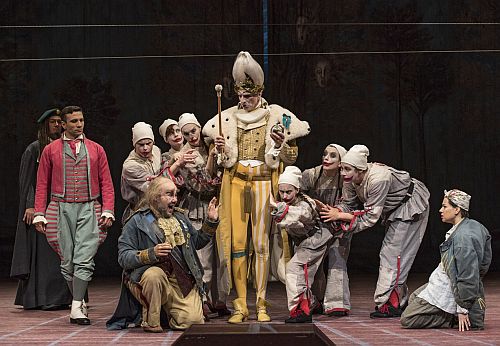 Sweden Gioachino Rossini: La Cenerentola Soloists, Gothenburg Opera Orchestra and male chorus, dancers, Giancarlo Andretta (conductor), Gothenburg Opera main stage, 14.5.2015 (NS)
Sweden Gioachino Rossini: La Cenerentola Soloists, Gothenburg Opera Orchestra and male chorus, dancers, Giancarlo Andretta (conductor), Gothenburg Opera main stage, 14.5.2015 (NS)

Cast:
Angelina (Cenerentola): Gaia Petrone
Clorinda: Mia Karlsson
Tisbe: Ann-Kristin Jones
Don Magnifico: Markus Schwartz
Don Ramiro: Sergey Romanovsky
Dandini: Åke Zetterström
Alidoro: Fredrik Helgesson
Dancers: Ulriqa Fernqvist, Gustaf Jönsson, Susanna Knutas, Morgan Karlsson, Lina Räftegård, Åsa Thegerström, Sara Suneson
Production:
Gothenburg Opera
Original direction: David Radok
Direction of the revival: Mattias Ermedahl
Set design: Ivan Theimer
Costume design: Katarina Hollá
Original lighting design: Torkel Blomkvist
Lighting design for the revival: Joakim Brink
Original choreography: Håkan Meyer
Choreography for the revival: Lina Räftegård
In the midst of a busy schedule of new productions the Gothenburg Opera has found time to revive a much-loved production of La Cenerentola by Rossini, originally premiered in 2003. The creative team behind the production is largely the same as for Gothenburg Opera’s Barber of Seville and as with that production the audience enjoy a feast for both eyes and ears.
Ivan Theimer’s set is stunningly beautiful, with warm pastel colours and a simple but ingenious system of curtains giving depth and the effect of scene changes without ever having to interrupt the flow of the music. Much of the work of manoeuvring the curtains falls to six dancers in commedia dell’arte costumes who are also the first performers on stage, dancing through the overture. Håkan Meyer and Lina Räftegård’s choreography is captivating and demonstrates the playful spirit of Rossini’s music. Indeed, the whole production is notable for a sense of dance and rhythm throughout, not just from the “official” dancers but also from soloists and chorus (not to mention the orchestra’s playing). For me this is one of the most attractive features of this excellent production.
Two of the roles are taken by the same soloists as in the original production, and in both cases they amply justify this choice. Markus Schwartz’ Don Magnifico is a superbly drawn buffa character, with a balance between the ridiculous side and his cruel streak (and sometimes, as in his opening aria, both at once). Mr Schwartz gives a convincing vocal impression of an old man but also does some delightful mimickry.
Åke Zetterström’s Dandini is delightful, making a first entrance so over the top that Don Ramiro buries his head in is hands in embarrassment. Mr Zetterström’s urbane baritone has the aristocratic hauteur of his Count in The Marriage of Figaro but exaggerated to comic effect. Mr Zetterström’s physical comedy is delightful (such as when he gets tangled in his foppish royal robes) and his sense of comic timing acute. Dandini’s high point is the scene where he reveals to a stunned Don Magnifico that he has been disguised and in real life is a mere valet.
Mia Karlsson’s Clorinda and Ann-Kristin Jones’ Tisbe strike sparks off each other. Their costumes emphasise the differences in their character and their acting is catty from the start and becomes only more so as they compete to become the Prince’s bride (or so they think). Fredrik Helgesson puts in a strong performance as Alidoro, vocally confident and spreading an aura of his character’s competence as everyone about him seems to lose their heads.

Sergey Romanovsky is a sensational Don Ramiro. His warm tenor is made for Rossini and his delivery is superb from his first entrance through the whole opera. He has both the technique to reach the heights of his range without sounding strained and an expression that comes to the fore in his duet with Cenerentola and in the scene in Act 2 where he vows to find the woman he loves. Mr Romanovsky also carries off the little comic touches that the production has for all the characters as a natural.
Gaia Petrone’s Cenerentola is gripping and after a slightly cautious start blossoms in her duet with Don Ramiro. Her silky smooth mezzo is wonderful to listen to, especially when she pleads with Don Magnifico to be allowed to go to the ball. Her coloratura is wonderfully musical, flowing like a chuckling stream and never seeming artificial. Ms Petrone also convincingly brings out Cenerentola’s remarkable goodness despite the years of humiliation she has suffered, especially in her wonderful final aria.
Giancarlo Andretta and the Gothenburg Opera Orchestra quickly shrugged off a slightly reserved performance of the overture and threw themselves in to the music. Mr Andretta brought out the rhythm and the contrasts in Rossini’s music, in particular leading superb staccato passages with the ensemble and orchestra. The tenors and basses of the Gothenburg Opera chorus were also on fine vocal form and threw themselves into the comedy with a will. All in all, an evening of non-stop fun that was rewarded at the end with a standing ovation.
Niklas Smith